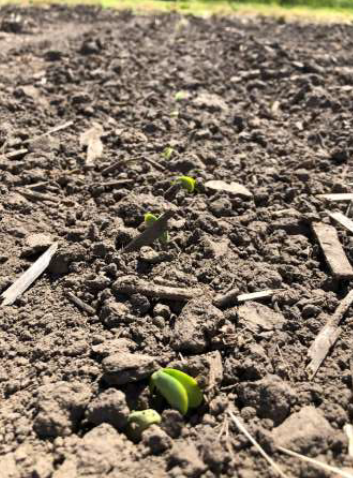ILSOYADVISOR POST
Risks For Soybeans Planted After Soybeans
Growers need to understand risks with continuous soybeans before addressing product placement. Remember the goal is to get an even stand with seedlings that emerge at nearly the same time and develop at the same rate (Figure 1).
In the past, most sources say that there can be up to 5 to 15% yield loss attributed to soybeans planted after soybeans if compared to a corn after soybean rotation. However, research done by Emerson Nafziger, at the University of Illinois, and conducted in Western Illinois revealed that yield loss with continuous soybeans was not as high as expected. The real secret is that soybeans planted after soybeans will require a higher level of management. Disease scouting, SCN infestation, field placement, fertility, weed management and product selection will all be factors to consider when trying to determine risks that could cause potential yield loss.
Varieties: When selecting soybean varieties, focus on disease resistance, especially if there is a field history with a specific disease. Most soybean varieties have disease ratings for Phytophthora, brown stem rot, SDS, frogeye leaf spot and white mold as well as SCN. It is also recommended that you rotate between soybean varieties, so that you are not depending on the same sources of resistance every year. Finally, a bushier variety can help achieve canopy sooner to aid in weed control, especially when planted in 30-inch rows.
Disease and SCN: A major disadvantage of a continuous soybean rotation is an increase in
diseases that overwinter in soybean residue such as bacterial blight, stem canker, pod and stem
blight, Septoria brown spot and frogeye leafspot. A major issue can occur if the field has had a history of Sudden Death Syndrome (SDS) or white mold. A reduction in population when beans are planted early as well as other cultural/biocontrols can be implemented for disease management. Fungicide application may be warranted at R3 (quarter inch pod on one of the top 4 nodes of plant) for fungal leaf diseases. For white mold, apply fungicide at R1, and if flowering occurs for an extended time, another application may be needed before R3. Lastly, the biggest problem is the potential for Soybean Cyst nematode (SCN) populations to increase.
Field Placement: As always, fields that have the best drainage are the most suitable areas for soybean growth. A back-to-back soybean rotation does not necessarily increase soilborne or root rot pathogens, but low lying or poorly drained areas in the field might be more vulnerable to root rot. Therefore, a seed treatment is highly recommended for early season root diseases and SCN protection, as well as insect control that offers an early season vigor effect.
Fertility: Each soybean crop can remove as much as 0.9 lb. of phosphorus (P) and 1.5 lbs. of potassium (K) per bushel of grain. The uptake of P, sulfur (S) and many other nutrients occurs throughout the soybean season, while the uptake of K and iron (Fe) occurs mostly late in the season, but also during early reproductive stages. Recent research has revealed that if nutrients such as P, N and S are lacking during reproductive growth, yield loss can result. During seed fill, grain tissues require remobilization and season-long nutrient accumulation. If soybeans are deficient in K, the amount of grainfill can be reduced. Soil tests become very important to help reveal nutrient removal levels and offer a basis for P and K replacement for the following year in order to keep nutrients and pH levels (6.5 - 7.0) in check, so that nutrients are available throughout the following growing season.

Doom plot near Athens, IL
Weeds: Weed resistance to a herbicide is more likely to occur in soybeans following soybeans because until recently, with the approval of additional herbicide resistant soybeans, it has been much more difficult to use herbicides with different mechanisms of action (MOA). Start clean and use a proactive, pre-plant or pre-emergence as well as a post that consists of a tank mixture or pre-pack with at least one MOA that is known to kill resistant weeds. This is done to prevent further resistant weed spread and, when combined with other weed control tools, can help relieve the selection pressure so that the MOA (known to kill resistant weeds) remains effective.




Comments
Add new comment